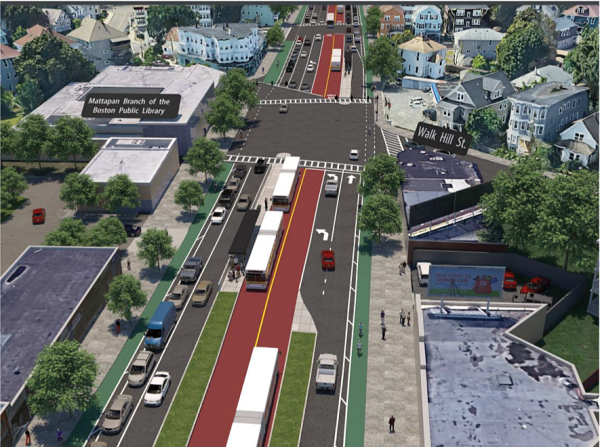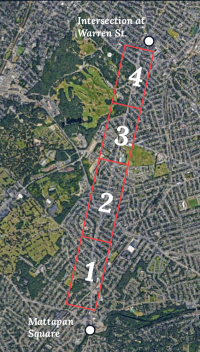February 1, 2023

A rendering from a Blue Hill Avenue Action Plan team presentation last year depicts how center-lane buses might be positioned near the Mattapan BPL branch. City of Boston image

The Blue Hill Avenue Action Plan team started its engines on Jan. 24 with the first of several monthly meetings set by city of Boston officials to discuss transportation transformation along Blue Hill Avenue. The subject du jour was the proposal for center-running bus lanes from Mattapan Square to Grove Hall.
The city, the MBTA, and some community members are very much in favor of a center-island plan, but vocal residents and businesses along on the corridor have consistently been skeptical or outright opposed to the concept.
Stephen Gray, a city-hired consultant, said that “the city does have an opinion about the benefits of bus-priority and potentially center-running bus lanes, so that is true,” but he also noted that “the city is also committed to only spend money on a project that has broad public support. So that means investment and infrastructure improvements on Blue Hill Avenue will happen no matter what folks decide at the end of the day – center-running bus lanes or not.
“The exact nature of the design will be determined through sustained engagement for those that live, work, and play along Blue Hill Avenue,” he said.
For all that, Gray and others hastened to stress that a $15 million federal grant secured for the project in 2021 can only be used for bus priority projects. “There are implications to different funding sources that are beyond the city’s control,” Gray said. “If bus priority is not a part of the project, then we should keep in mind the scale of what the city would need to raise changes if that’s not involved.”
Most of the meeting featured officials with a positive view of the center-lane bus talking with community members who are not in favor.
“Drivers race up the bus lane when there is heavy traffic, then the bus gets stuck behind cars and that is what is happening on Mass Ave in Cambridge by MIT,” said Cheryl Spence in the online chat. “The center bus lane reminds me of the Green Line, and having people wait in the middle of the road is scary.”
Added Joseph Eubanks Jr.: “Cut service and continued gentrification. People are not giving up their cars or vehicles because of middle bus lanes. Sometimes traffic is backed up from Muffler Mart at Amory Street to Walnut Avenue or rather Franklin Park along Columbus Avenue (where there is a center-running bus lane now).”
Diane Bell said simply, “We don’t want this for our neighborhood. No.”
In response, MBTA officials like Andrew McFarland made the case for the lanes. He noted that 20 to 50 percent of people now living on the corridor don’t have access to a vehicle. Moreover, he said, 12,000 riders get on and off the buses each day on Blue Hill Avenue south of Morton Street, and 5,573 riders do the same at Grove Hall. Those thousands of riders, he noted, now experience delays along the corridor because of congestion.
That is one of the main reasons why the MBTA and the City of Boston are in favor favor of the plan, he said. “We believe this will speed up the buses and make them more reliable – removing them from traffic and making sure they get you where you need to go. We estimate that if the center-running bus lanes are built, they can reduce transit travel times significantly on the corridor, meaning they can take as few as 15 minutes to travel from Mattapan Square to Grove Hall.”
Andre Martin, of Dorchester, said young people in the area support the center-running bus lanes.
“Given the way things are going it is very obvious for some of us young folk that designing your city for cars is not sustainable,” he said. “A lot of us are looking to live car-free and having more transit options in the future would be beneficial for riders and the community as a whole…I do think getting the center-running bus lanes is an absolute boon for the community.”
It seemed, though, that for every lanes supporter, there were two or three voices opposed for numerous reasons.
“There aren’t many bikes on Blue Hill Avenue unless you mean those motorbikes that terrorize drivers in the summer,” wrote Cynthia Moore. “The same with the bike lanes on American Legion – a waste.”
Community leaders like Michael Kozu of Grove Hall and Louis Elisa of Garrison Trotter Neighborhood Association are also skeptical.
To address concerns “in real time,” the Action Plan team pledged to undertake several studies that would steer the process so that “informed, data-driven decisions” can be made, Gray said.
The input will include a post-implementation review of the Columbus Avenue center-running bus lane that was put into place in 2020; a housing impact study to investigate how to combat gentrification that could come after significant public investment; and a parking study to determine demand and solutions for problematic double- and triple-parking situations that now exist.
The final commitment from the Action Plan team was a prioritization of pedestrian safety. “What we’ve heard from folks is that it’s not just about the transportation service, which is something that needs to be addressed and improved, but it’s also about crumbling sidewalks and roadways and inappropriate timing on signals for crossing and driving,” said Gray.
That sentiment was seconded by Rev. Miniard Culpepper, who wondered what the process would look like without so much center-lane bus chatter.
“We’re focused so much on the bus lane,” he said. “If we took the bus lane off the table, how could we approach Blue Hill Avenue so that everyone would come out with a win? Everyone is just too focused on this bus lane.”
The next meeting will be on Tuesday, Feb. 28, online at 6:30 p.m. However, other forms of outreach will continue, including weekly drop-in sessions at the Mattapan Square station from noon to 2 p.m. In the near term, the team said they would be offering similar drop-ins at Grove Hall.


